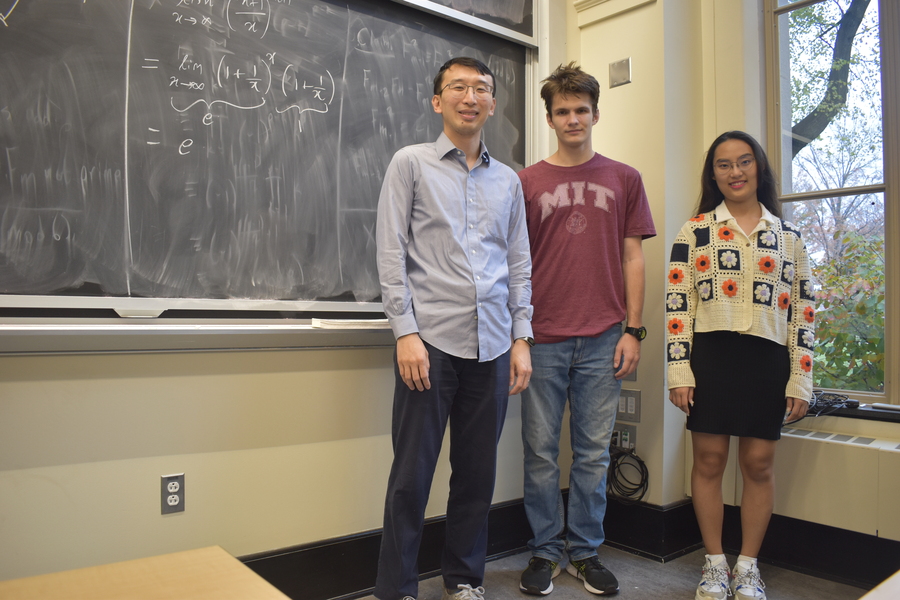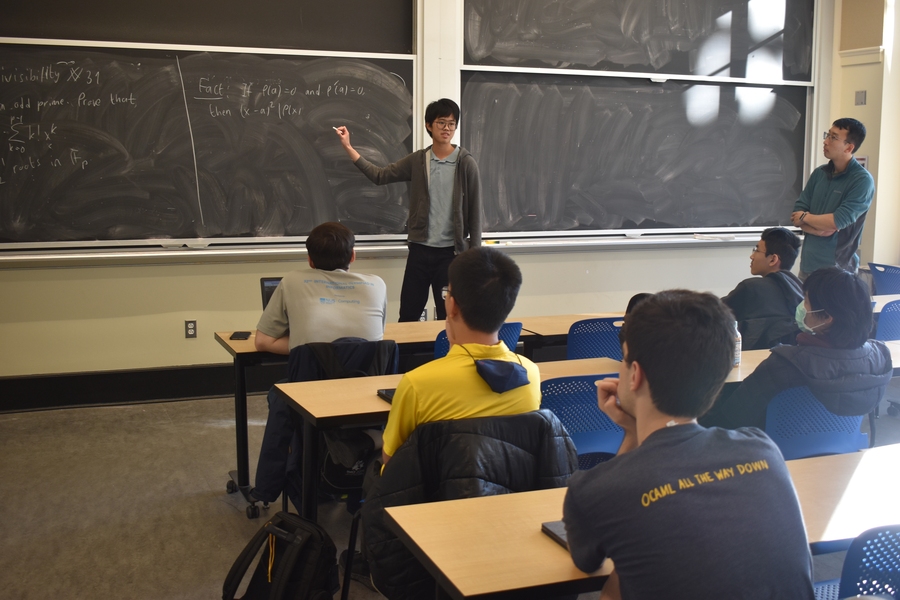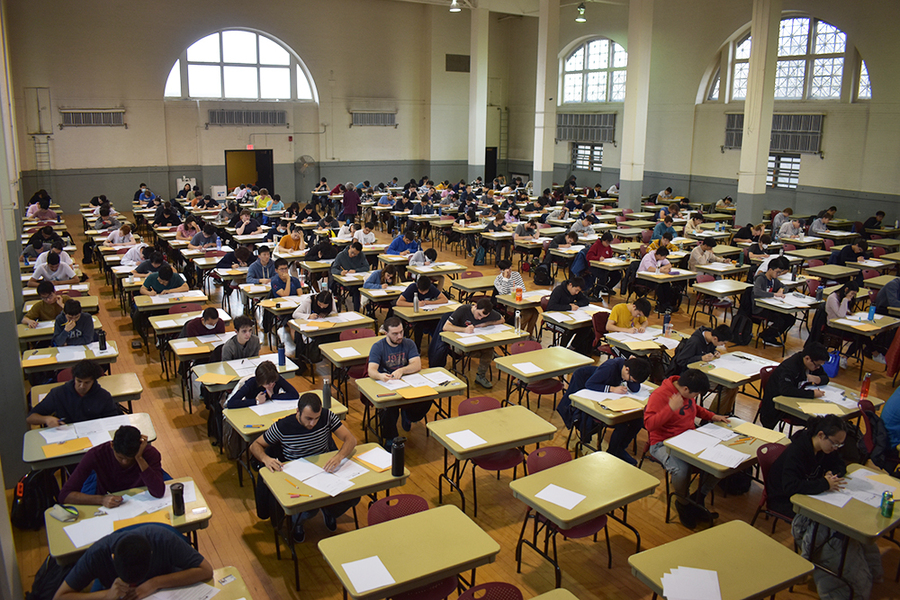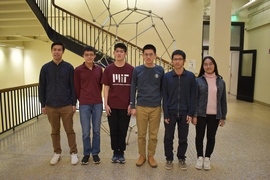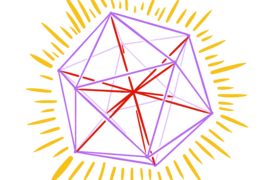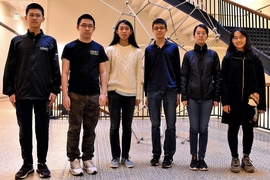Mark Saengrungkongka, a first-year MIT undergraduate student, stood at the blackboard and explained his solution to a math problem similar to the ones that might appear on the William Lowell Putnam Mathematics Competition, a prestigious annual math competition for college students in the United States and Canada administered by the Mathematical Association of America (MAA). After he finished presenting his proof, the class gave a round of applause. “That was a very nice solution,” math professor Yufei Zhao told the class.
It was a few weeks into the semester, and while there were a few latecomers, students in Class 18.A34 (Mathematical Problem Solving) paid close attention to the intricate proofs presented by their fellow students on the blackboard. The audience asked probing questions and pointed out gaps in the arguments.
This undergraduate seminar, better known as the Putnam Seminar, brings together first-year students who are interested in the annual competition. In recent years, MIT has finished first in the December exam, and all five top-scoring students, known as Putnam Fellows, were from MIT the past two years.
But the Putnam exam is also designed to just instill a love of math to all who attempt the insanely hard problem sets. One of the goals of Zhao’s class is to make solving these problems more like participating in a fun group puzzle rather than a stressful competition. For many first-year students, it’s also a nice way to ease into MIT life.
“The students in the seminar usually come in with a strong preparation from math competitions,” says Zhao. “But college is rather different from high school math Olympiads. A goal of the seminar is to help them transition from a high school math Olympian to a successful college student and beyond.”
Each week, Zhao starts his seminar gently, with a casual discussion. He asks the classes how they are feeling about the semester and talks about life as a college math student. Discussions include class selections, dealing with setbacks, and career paths. One student asks about how to find research opportunities; another student asks about recommendation letters.
Zhao knows that his students are already thinking ahead about upper-level math classes, but he hopes to slow them down a little so that they can take their time to really understand and appreciate what they are learning. “There’s a tendency for these students to do too much,” he says.
About 10 minutes after the start of the class, Zhao wraps up the discussion and starts the student presentations.
Mohit Hulse presented a solution to a combinatorics problem from the 2018 Putnam Competition. When he realized that he made a small mistake in the middle of his presentation, there was some supportive laughter, and he confidently continued on. The audience was respectful, and his classmates often helped with an idea.
When he was finished, Zhao added compliments and tips. “I suggest looking up the proof of the Chernoff bound, which is quite similar,” he says. “That was a nice solution.” He then pointed to the board and gave some suggestions. “I thought this step could be omitted.”
In addition to discussions and student presentations, the seminar also features weekly lectures by upper-year students, including veterans of the Putnam Seminar. The lectures highlight math problem-solving techniques useful for the Putnam Competition as well as provide a lens into advanced mathematics.
This year, roughly 60 incoming first-year students applied to the Putnam Seminar, among which 21 were selected. The seminar is internationally diverse, with students from 10 countries outside the United States: Australia, Armenia, Canada, China, Georgia, India, Korea, Portugal, Singapore, and Thailand.
“This class builds connections,” says Zhao. “All of them are new to MIT, and many are arriving in the U.S. for their first time. They are all interested in mathematics. I hope that the seminar will help them meet other students and form a supportive community.”
Any MIT student is welcome to attend the lectures, although the presentation sessions are restricted to the seminar students. These problem sets are also made available through MIT OpenCourseWare for other interested students and teachers.
Practicing presentations
The seminar is designed to provide a rare chance for first-years to develop their mathematical communication skills, including blackboard presentation and proof writing. Zhao says he has been innovating on the format of the seminar in recent years, with ever-increasing emphasis on oral presentation practice and feedback.
“Undergraduates don’t get a lot of presentation opportunities, especially blackboard presentations,” says Zhao. “We hear a lot from MIT alumni that they wish they had received more training in communication skills at MIT.”
Two previous seminar students, senior Dain Kim and sophomore Tomasz Ślusarczyk, help the class as undergraduate assistants. Last year, Kim ranked sixth place in the competition, and was awarded the Elizabeth Lowell Putnam Prize for being the top female scorer, and Ślusarczyk earned an honorable mention. As undergraduate assistants, Kim and Ślusarczyk hold regular office hours where students come to practice presentations to a small audience of a few other students, without the professor present. These office hours started last year in response to students seeking more presentation opportunities outside classroom hours.
Kim says that she benefited a lot from taking the seminar as a first-year student.
“Especially in math classes at MIT, it is hard to get a chance of giving a presentation to other students, unless it is a CI-M [Communication Intensive in the Major] class, because most classes are lecture-based,” Kim says. “I could hear from other students how they approached the problems that I could not solve, and I could also practice math presentations.”
Ślusarczyk, who took the seminar last year, credited the class with transitioning some of his math contest approaches and mindset to research-oriented mathematics. “Combining the problem-solving focus with a higher level of mathematical maturity was definitely a great educational experience and improved my Putnam skills a lot,” he says. “The skills developed in the seminar were invaluable during problem-set sessions, office hours, or research meetings. The class definitely helped me a lot with my career plans — I learned a lot about research-oriented math and decided that I want to pursue research in a math PhD program after graduation.”
The competition
The Putnam exam was founded in 1927 by Elizabeth Lowell Putnam in memory of her husband William Lowell Putnam, and has been offered annually since 1938, administered by the Mathematical Association of America.
Last year’s grueling six-hour exam featured 12 proof-based math problems, each worth 10 points, drawn from calculus, algebra, geometry, combinatorics, number theory, and more. The 2021 exam was taken by 2,975 undergraduates from 427 institutions, 150 of them from MIT.
The top score was 119 out of 120 points, with the median score a mere four — which meant that most students did not fully solve a single problem. But of the top 105 scorers who finished with honorable mention rankings or higher, 63 were MIT students.
The top five scorers receive the prestigious title of Putnam Fellow. For the second time in the competition’s history, all five Putnam Fellows came from MIT, and they were all Putnam Seminar alumni. In the more than 80 years of the Putnam Competition, only eight competitors achieved the rarified four-time Putnam Fellow status, including three from MIT. MIT math professor (and former MIT Putnam coach) Bjorn Poonen was one such four-time Putnam Fellow when he was an undergraduate at Harvard University.
Back in 1973, when MIT math professor Richard Stanley started teaching at MIT, he noticed that MIT had a large number of students taking the Putnam. He had taken the exam three times during his Caltech years.
“My best result was ninth overall,” he recalls. “At that time, Caltech was the dominant Putnam school. I can remember my freshman year one of the persons in my student house complaining that although he was seventh in the country, he was only fourth at Caltech and second in his hallway!”
When he looked at how MIT students fared on the exam, he thought that there was room for improvement.
“I thought that a seminar on problem-solving might stir up some interest and benefit the students,” he recalls.
Stanley’s undergraduate seminar on mathematical problem-solving featured his weekly lecture devoted to a Putnam-related topic such as number theory, linear algebra, generating functions, or inequalities. “These are huge subjects, but the lectures were very narrowly focused on providing background and examples for doing well on the Putnam,” says Stanley.
He would then assign two problem sets each week, one based on the lecture, and another dedicated to “fun” problems. The second class that week had students discuss their solutions.
“The class’s second focus was just the enjoyment of problems,” he says. “Many math students enjoy problem-solving and the opportunity to learn interesting tidbits from all areas of math that are not likely to be found in standard classes. They also like the camaraderie of friendly competition.”
Stanley was also the Putnam coach for about 35 years, later joined by Professor Hartley Rogers. The Putnam class seemed to pull MIT students into many first-place team victories. Eight alumni from that seminar eventually became Stanley’s PhD students, and he wrote a book, “Conversational Problem Solving,” based on his seminar.
Above all, Stanley emphasizes putting the fun in Putnam. Besides, he says, there’s a downside to all the winning.
“It is as if the Red Sox dominated all other teams every year and won every World Series in four games,” says Stanley. “Great for Boston fans, but not for baseball in general.”
As a first-year student in 2006, Zhao attended the Putnam seminar taught by Stanley and Rogers and went on to earn three Putnam Fellow spots; he missed the fourth by a single point. When he returned to MIT in 2017 to join the faculty, he began teaching the Putnam Seminar.
Zhao credits Stanley for creating high-quality problem sets, which are still being used in the seminar. And Zhao is also continuing Stanley’s goal to steer students away from seeing the seminar as simply training for Putnam.
“The class helped me to take the Putnam exam as a by-product,” says Kim. “Every week I solved a problem set, and I enjoyed trying some hard problems. It helped me to get used to Putnam-type problems. But this is not just a ‘Putnam preparation class.’ Although we are talking about Putnam problems and some concepts appear there, the goal of the class is not ‘raising the scores of participants.’”
At the beginning of a late-November seminar, Zhao asked his students how they felt about the upcoming exam in less than two weeks, and a few mentioned the word “stressed.” But others said how much they just enjoyed working on the problems. “I want to take it without much pressure,” said one student. Added another, “What works for me is that I’m competing with myself, and not others.”
Zhao then gave the class his most valuable advice: “Make sure you get lots of sleep the days leading up to the exam.”
